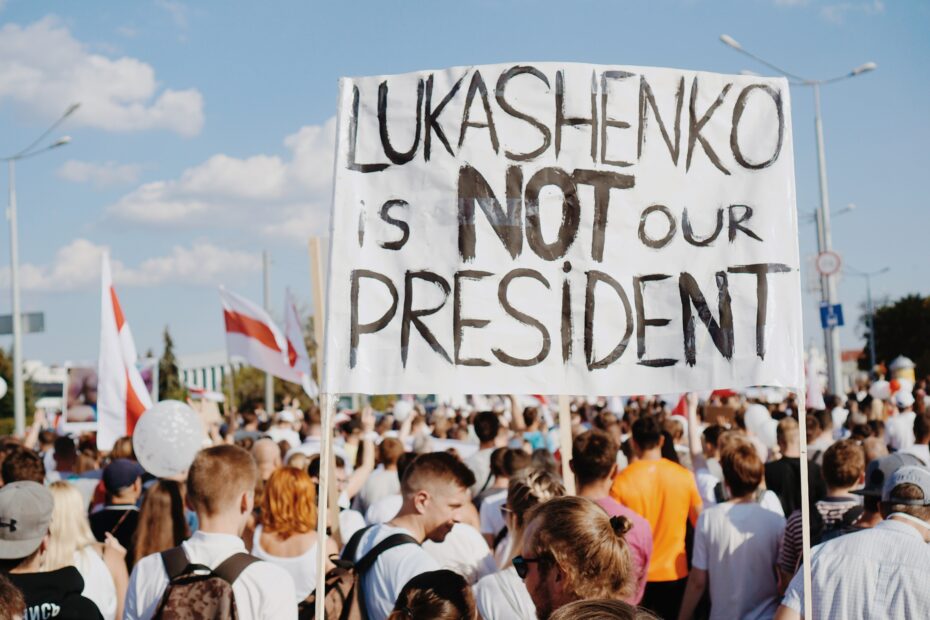Aleksandar Lukashenka’s counter-revolution will not be televised.
Belarus’s President Aleksandar Lukashenka — who is still clinging on to power three months after an election he claims to have won, but which most observers are certain he lost — evidently hopes he can win a war of attrition against his country’s entrenched opposition. A remarkably broad coalition of protesters is digging in for a long winter, as they continue to try to deny him the power he seeks. They have already won a crucial battle: Belarusians have tuned out their dictator.
Most Belarusians don’t watch state TV
In a new survey of media consumers in Belarus, conducted in late September by King’s College London and Sociolytics, fewer than one-third of respondents said they watch the country’s four state-owned TV stations with any regularity, and 45 percent said they never get any news from TV. In contrast, 75 percent said they get news from online social media at least several times a week, including 46 percent who turn to Telegram — the online messaging service that hosts the popular pro-opposition news channel Nexta. Tut.by, an independent online news site that was blocked by the government in the early days of the protests, is now the country’s most trusted news source, used on a daily or near-daily basis by 59 percent of respondents.
The survey also suggests Lukashenka can’t claim the attention of any discernible social group. While younger people are more likely to consume oppositional media than their elders, a majority of every age cohort in the survey has tuned out state-run media altogether (the numbers range from 85 percent among those aged 18-24 and 25-34, to 52 percent among those 55 and older). The same pattern holds across all regions of the country and the capital city, Minsk, among all employment sectors, and among all levels of education.
The contrast to neighboring Russia is striking. There, in another survey run by King’s College London in August 2019 — in the aftermath of rolling protests against the Kremlin’s management of local and regional elections, and at a point when Vladimir Putin’s approval ratings were hovering at an all-time low — 73 percent of respondents said they watched Russia’s state-run Channel One for news at least several times a week, while 62 percent of respondents got all or most of their news from state-backed sources. Interest in oppositional media in Russia was and remains limited to younger citizens, residents of Moscow and St. Petersburg, and those with higher levels of education, that survey showed.
In other words, where Vladimir Putin has succeeded in limiting the audience for opposition messages to certain segments of society, Lukashenka has failed.
Coronavirus prompted Belarusians to turn to more accurate news sources
Why did this happen? Our research builds on ideas about “informational autocracy” developed by two social scientists, Sergei Guriev and Daniel Treisman. Guriev and Treisman argue that modern autocrats don’t rule through an iron fist alone. Rather, they use a combination of policy and propaganda to convince their subjects that they are competent. This means that when policy fails, propaganda can pick up the slack. However, when both fail, revolution ensues.
The Belarusian case suggests there’s an intermediary step: turning off the TV. Evidence from our in-depth interviews, run alongside the survey, suggests that it was not, in fact, only the August election and the brutal repression of the ensuing protests that led Belarusians to turn off the TV and download Telegram. Instead it was Lukashenka’s insistence that the coronavirus pandemic was all a hoax that first triggered the exodus to the Internet. Left to deal with the very real pandemic in the absence of usable news and official guidance from the government, Belarusians began seeking other sources of information, and trust in state media plummeted.
Belarus, of course, is no stranger to propaganda and censorship. But despite a near monopoly on traditional media and severe restrictions on the Internet, when Lukashenka most needed his subjects’ attention, they had already shifted their gaze elsewhere. Some 53 percent of our respondents said that they had begun using new sources of media in recent months, including 32 percent who had discovered Telegram, and 30 percent who had turned to Tut.by. Belarusians began relying on each another more, too: some 34 percent of respondents said they talked with friends, family and colleagues about politics more than before.
Draconian restrictions on survey research in Belarus meant that we could not ask direct questions about politics, including support for Lukashenka or the protesters. Nonetheless, respondents ranked freedom of speech and constitutional reform fourth and fifth, respectively, among the most pressing issues faced by the country, following economic growth, the covid-19 pandemic and poverty. Not surprisingly, democratic priorities ranked somewhat higher — fourth for constitutional reform and first for freedom of speech — among those respondents who tend to consume more oppositional media, and much lower among the minority who watch state television (twelfth and seventh, respectively).
We can’t say what is causing what: we don’t know whether people choose to consume media that supports their views on politics, or whether their views are shaped by the media they consume. However, media choice appears to be the most important dividing line when it comes to Belarusians’ opinions about politics. And when it comes to the media, the bad news for Lukashenka is that most Belarusians seem to have made up their minds.
